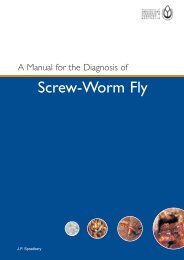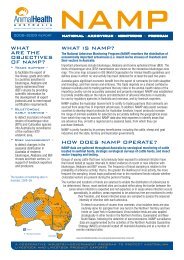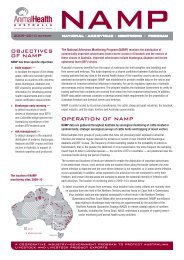National Livestock Identification System Alpaca and Llama ...
National Livestock Identification System Alpaca and Llama ...
National Livestock Identification System Alpaca and Llama ...
Create successful ePaper yourself
Turn your PDF publications into a flip-book with our unique Google optimized e-Paper software.
NLIS ALPACA AND LLAMA DATABASE OPTIONS REVIEW<br />
1999 which concluded that the traceability arrangements for the Australian cattle<br />
industry did not meet the EU requirements.<br />
As a result of a potential ban on exports to the EU, the cattle industry <strong>and</strong><br />
government hastily agreed to implement the NLIS on a limited basis to supply<br />
product to the EU from a “closed” system. This required the establishment of a<br />
database to record device issue, movements <strong>and</strong> eligibility. The interim database<br />
was commenced in the middle of 1999 <strong>and</strong> was operational by November of that<br />
year. Development was carried out by external developers under management by<br />
MLA.<br />
Once the basic functionality of the system had been established, MLA decided to<br />
request expressions of interest from organizations interested in developing the full<br />
system. After a full evaluation of responses, it was decided that MLA would continue<br />
to manage the ongoing development using the initial company Catjes Pty Ltd. This<br />
arrangement continued until 2006 when the development team was employed<br />
directly by MLA <strong>and</strong> development was brought in-house.<br />
The database has evolved over the last 10 years with increasing complexity <strong>and</strong><br />
functionality. While the system has a lot of functions that will not be required by the<br />
alpaca <strong>and</strong> llama industries at present, it is far more economical to turn off these<br />
functions rather than having to build them at some future date. An example of this is<br />
the carcass feedback section which allows for carcass data to be uploaded by the<br />
abattoir <strong>and</strong> made available to the breeder <strong>and</strong> consignor.<br />
The database operates under an industry agreed Terms of Use (ToU) which<br />
determine who can view data, who can add data, who can change data, etc. This is<br />
of critical importance since the data held is from a variety of sources including<br />
producers, saleyards, abattoirs <strong>and</strong> government. The discussion is not about who<br />
owns the data but who has access to it.<br />
The database has been operating now for 10 years. The range of functions <strong>and</strong><br />
interactions has progressively been increased over this period. All the functionality<br />
has been fully tested, both before release <strong>and</strong> then in operation, for a considerable<br />
period of time.<br />
Funding for the development of the database has come from levies collected from<br />
the red meat industries (cattle sheep <strong>and</strong> goats) <strong>and</strong> funding from the federal<br />
government. This funding has been from federal R&D matching funding or special<br />
funding through DAFF.<br />
In early 2009, the NLIS portion of MLA was transferred to an autonomous company,<br />
still within the overall umbrella of MLA. The new body is called <strong>National</strong> <strong>Livestock</strong><br />
<strong>Identification</strong> <strong>System</strong> Ltd. It now operates under its own board although this board is<br />
MLA nominated. This should not result in large changes to the operation of the<br />
system but will give the new organization greater autonomy, particularly with those<br />
groups outside of the cattle <strong>and</strong> sheep industries which pay levies to MLA.<br />
Page 18





